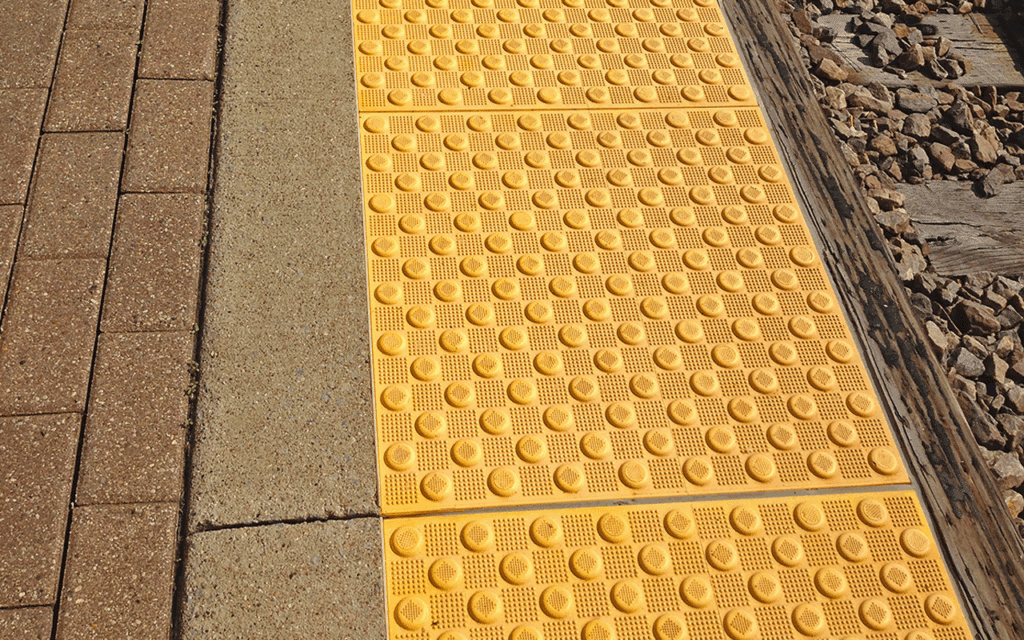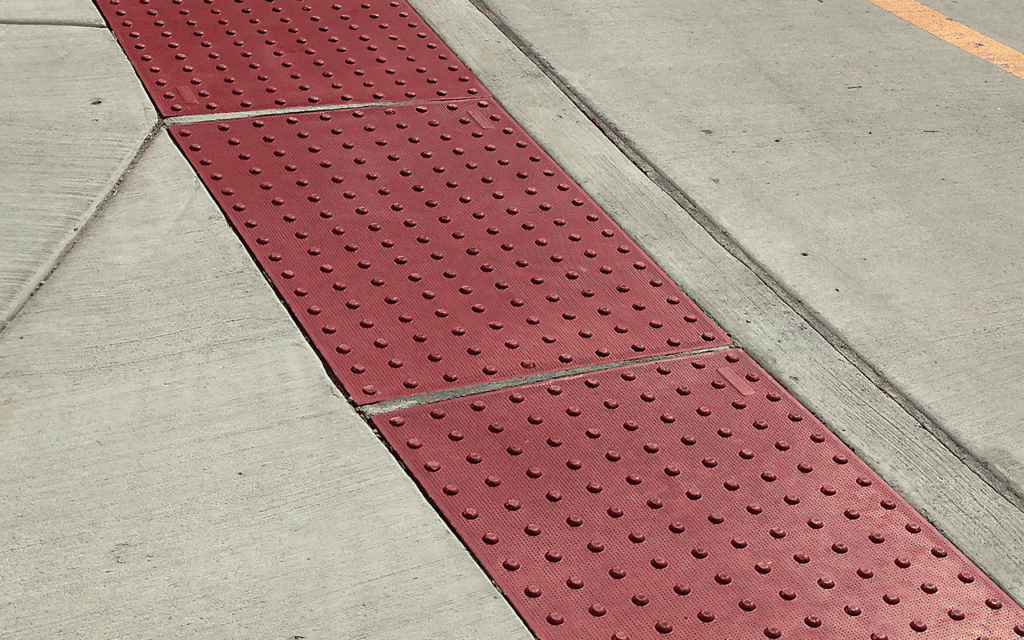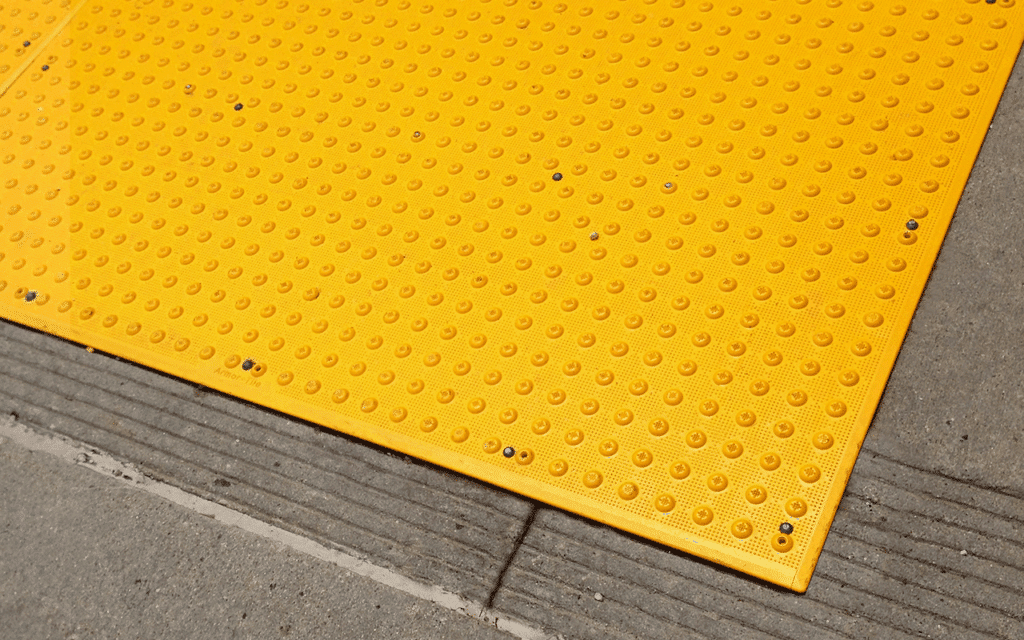What Are Truncated Domes? A Complete Guide to ADA Detectable Warnings

If you manage a commercial property, design public infrastructure, or are responsible for ADA compliance, you’ve likely come across the term truncated domes. You’ve probably seen them too—rows of raised bumps arranged in a grid pattern on sidewalk ramps, transit platforms, and curb cuts.
But what exactly are truncated domes, where are they required, and why are they so important to accessibility and public safety?
This guide will walk you through everything you need to know about ADA truncated domes, including their function, placement guidelines, design specifications, and how to ensure your project is fully compliant with federal standards.
What Are Truncated Domes?
Truncated domes are a type of detectable warning surface designed to alert pedestrians—particularly those with visual impairments—to changes in their environment. They consist of a grid of raised, rounded bumps with flat tops, allowing them to be easily felt underfoot or detected with a cane.

Truncated domes serve as a vital early warning system for people who are blind or visually impaired, signaling that they’re about to transition from a safe pedestrian zone to a potentially hazardous area like a street or train platform.
These tactile surfaces are most commonly installed at:
Curb Ramps
Transit Platform Edges
Pedestrian Crossings
Parking Lot Access Routes
Building Entrances
Why Are Truncated Domes Important?
Truncated domes are an essential component of universal design and ADA compliance. Their importance lies in their ability to:
Enhance Public Safety
They provide a non-visual cue to stop and assess surroundings—especially in high-traffic areas where danger may not be immediately visible.
Promote Independence
By using tactile warnings, individuals with visual impairments can navigate public spaces safely and independently without requiring constant assistance.
Ensure Legal Compliance
For public facilities and commercial properties, failing to install proper ADA truncated domes where required can lead to lawsuits, non-compliance penalties, or withheld occupancy permits.
Where Are Truncated Domes Required?
Common Required Locations:
- Curb Ramps: Every new or altered curb ramp must have a detectable warning surface at the bottom.
- Pedestrian Crosswalks: Where walkways enter a vehicular roadway without a curb.
- Transit Platforms: Along the edge of train or bus platforms.
- Accessible Parking Areas: Access aisles adjacent to handicap parking spaces, where applicable.
- Shared-Use Paths and Trails: Where pedestrian paths cross roadways or driveways.

According to the Americans with Disabilities Act (ADA) and Public Right-of-Way Accessibility Guidelines (PROWAG), truncated dome placement is required in specific scenarios where pedestrian pathways intersect with vehicular routes or platform edges.
While requirements may vary slightly by jurisdiction, these guidelines are widely adopted under federal and local building codes.
When Are They Not Required?
- Driveways without pedestrian crosswalks
- Private residential properties not open to the public
- Temporary or unaltered existing facilities (unless undergoing renovation)
Always consult your local ADA authority or municipal building department to ensure your project meets current requirements.
ADA Specifications for Truncated Domes
To be compliant with ADA regulations, truncated domes must meet very specific design criteria.
Dome Size & Spacing
- Diameter: 0.9 inches (22 mm)
- Height: 0.2 inches (5 mm)
- Center-to-center spacing: 1.6 to 2.4 inches (41–61 mm)
Surface Area
The detectable warning surface must extend the full width of the curb ramp and be at least 24 inches deep.
Alignment
Domes must be aligned perpendicular to the direction of travel.
Slip Resistance
Surfaces must be slip-resistant, even when wet.
Contrast & Color
The dome field must have a visually contrasting color to the surrounding walking surface. The ADA does not mandate a specific color, but yellow and red are commonly used for high visibility.
By meeting these specifications, detectable warning surfaces ensure usability while reducing the risk of slips or falls.
Truncated Dome Materials & Installation Options
There are several types of truncated dome products available, including:
1. Cast-in-Place Domes: ~$300-500
These are embedded into freshly poured concrete and are ideal for new construction projects. They provide permanent durability.
Pros:
- Durable and long-lasting—ideal for high-traffic areas
- Permanently embedded, resistant to shifting or peeling
- Low maintenance once installed
Cons:
- Only suitable for new concrete pours (not for retrofits)
- Higher upfront cost compared to other options
- Requires skilled labor and longer installation time
2. Surface-Applied Domes: ~$100-$200
Installed with adhesives and/or fasteners onto existing surfaces. A cost-effective solution for retrofitting older sidewalks or ramps.
Pros:
- Cost-effective retrofit option for existing sidewalks or ramps
- Faster installation with minimal disruption
- Can be replaced or repaired without removing the concrete underneath
- Available in multiple materials and colors for visibility
Cons:
- Requires more frequent inspections and potential maintenance
3. Modular Tiles or Panels: ~$200 per tile
Often used in large areas or facilities like train stations, schools, or hospitals. These are quick to install and easy to replace.
Pros:
- Ideal for covering large areas quickly
- Easy to replace individual panels without redoing the entire surface
- Flexible layout options for custom configurations
- Good for both indoor and outdoor applications
Cons:
- Higher material cost for large-scale projects
- May require more seams, which can collect debris or moisture
- Not as visually seamless as single-piece installations
At HandiRamp, we offer a variety of ADA-compliant options tailored to your surface type, usage needs, and long-term maintenance goals.
Truncated Dome Placement: Best Practices
Placement Tips:
- Align domes at the bottom landing of curb ramps.
- Place domes 2 inches from the curb line to allow cane detection before entering the street.
- Ensure full-width coverage across the pedestrian path.
- Maintain level transitions between dome panels and the surrounding surface.

Proper truncated dome placement is essential for effectiveness and compliance. Incorrect positioning can render them ineffective or even hazardous.
In public rights-of-way, designers should consult the PROWAG (Public Right-of-Way Accessibility Guidelines) standards alongside ADA requirements to ensure full compliance.
Who Is Responsible for Compliance?
Responsibility typically falls on the property owner, developer, or managing agency overseeing the construction or renovation project. This includes:
- Commercial property managers upgrading sidewalks or parking lots
- Contractors and architects designing new buildings or pedestrian zones
- Municipal planners creating or improving public infrastructure
- Schools and hospitals installing access routes
Non-compliance can result in:
- Project delays
- Failed inspections
- Accessibility lawsuits
- ADA violation fines
Why Choose HandiRamp for Detectable Warning Solutions?
At HandiRamp, we’ve spent decades helping organizations create accessible, compliant spaces that serve the needs of all users. Our selection of ADA truncated domes and detectable warning surfaces meet or exceed federal guidelines.
What We Offer:
- Expert guidance on truncated dome placement and layout
- Durable aluminum construction engineered for outdoor conditions
- Quick and easy installation
- Multiple color options
Whether you manage a retail space, transit center, or municipal sidewalk network, we can help ensure your property meets the highest standards of accessibility and safety.
Looking for reliable truncated domes or guidance on truncated dome placement? Need help sourcing ADA truncated domes for your project? HandiRamp is your go-to provider for code-compliant detectable warning surfaces you can trust.At HandiRamp, we’ve spent decades helping organizations create accessible, compliant spaces that serve the needs of all users. Our selection of ADA truncated domes and detectable warning surfaces meet or exceed federal guidelines.
Final Thoughts
Truncated domes are more than a regulatory requirement—they’re a critical tool for helping individuals with visual impairments navigate the built environment independently and safely.
Understanding where they’re required, how to install them correctly, and how they contribute to ADA compliance is essential for anyone involved in public design, construction, or facilities management.
If you’re working on a project that involves curb ramps, pedestrian access points, or transit facilities, don’t overlook the importance of proper detectable warning surfaces. Let HandiRamp be your partner in delivering compliant, inclusive infrastructure.
Need Help?
Call us today at 800-876-7267 to speak with an ADA accessibility expert and find the right truncated dome solution for your property or project.

